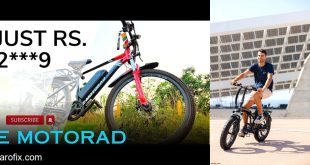How to Customize a RadRunner Like a Pro?
The RadRunner isn’t just an electric bike—it’s a blank canvas waiting for your personal touch. Whether you’re commuting through busy streets, hauling groceries, or cruising for fun, customizing your RadRunner can transform it from a functional e-bike into a statement of style, comfort, and efficiency. Let’s dive deep into how you can make your RadRunner uniquely yours while optimizing performance, utility, and sustainability.
Understanding the RadRunner’s Core Features
Before you start swapping parts or adding accessories, it’s essential to understand the RadRunner’s baseline capabilities:
- Motor: 750W geared hub motor with pedal assist up to 20 mph (Class 2 e-bike).
- Battery: 48V 14Ah battery, easily swappable, offering around 25–45 miles per charge depending on terrain and load.
- Frame: Robust steel frame with integrated rear rack and modular design for carrying cargo.
- Components: Mechanical disc brakes, Shimano drivetrain, and adjustable seat post for comfort.
Knowing these technical details helps you choose upgrades that complement the RadRunner rather than compromise it.
Customizing Your RadRunner: Step-by-Step Guide
1. Upgrade the Comfort
Comfort is king if you ride daily. I swapped my stock saddle for a gel-padded ergonomic seat, and it was life-changing on longer commutes. Combine this with adjustable handlebars or a suspension seat post for smoother rides, especially on bumpy urban streets.
- Tip: Choose components compatible with the RadRunner’s steel frame to avoid fit issues.
2. Optimize Cargo and Utility
The RadRunner is built for cargo, but you can push it further:
- Rear Racks & Baskets: Add a lockable rear trunk or a modular basket. I often carry groceries, tools, or even a small dog in mine!
- Panniers & Bags: Waterproof panniers can hold laptops or groceries securely without affecting bike balance.
- Accessory Mounts: Attach a frame-mounted bottle holder, smartphone mount, or modular rack system.
3. Boost Performance
While the RadRunner is already capable, there are ways to fine-tune it:
- Tire Upgrades: Switch to puncture-resistant, wider tires for better grip and comfort. I once went on a gravel path with stock tires—lesson learned, bigger tires are a game-changer.
- Motor Assist Settings: Adjust pedal-assist levels based on your terrain. Some riders use a smartphone app or third-party display to fine-tune torque delivery.
- Chain & Drivetrain: Consider upgrading to a smoother Shimano drivetrain for less maintenance and longer lifespan.
4. Lighting and Safety Enhancements
Urban riding at night or in poor weather demands good visibility:
- Install high-lumen front and rear lights, ideally USB-rechargeable for convenience.
- Add reflective tape or decals for extra safety.
- Consider a horn or bell upgrade—some electronic bells are surprisingly loud and compact.
5. Personal Style and Aesthetics
Why settle for stock colors when you can make your RadRunner pop?
- Custom Paint or Wraps: Vinyl wraps are affordable and reversible. I gave my RadRunner a matte black look with neon accents—it turns heads every time.
- Handlebar Grips & Seat Covers: Match your color theme or add comfort with cushioned, stylish grips.
- Accessories: Mudguards, cable sleeves, and even small frame decals can make your bike uniquely yours.

Frequently Asked Questions
Can I increase the speed of my RadRunner safely?
Technically, yes, but it’s not recommended to exceed the Class 2 limit of 20 mph. Upgrading to a higher-powered motor or removing speed restrictions may void your warranty and compromise safety.
What’s the easiest way to carry heavy loads?
Use a combination of the rear modular rack and panniers. For extremely heavy items, consider a front basket or even a trailer. I once hauled a 30kg crate of tools—balancing weight front and rear made it manageable.
How often should I maintain my RadRunner?
Monthly checks are ideal: tire pressure, brake pads, drivetrain lubrication, and battery health. Deep cleaning every few months prevents rust and ensures smooth performance.
Can I ride my RadRunner in all weather conditions?
Yes, but water-resistant accessories and fenders are a must. For winter riding, studded tires and waterproof gloves make a huge difference.
Is it worth customizing if I’m a beginner?
Absolutely! Start small: grips, lights, or a saddle upgrade. Gradually, you’ll understand your riding needs and can invest in bigger mods without wasting money.
Future Trends and Innovations
Electric bikes are evolving fast. Here’s what’s coming:
- Smart Connectivity: Apps that monitor battery life, route efficiency, and theft alerts are becoming standard.
- Lightweight Materials: Carbon or aluminum frames for better handling without compromising strength.
- Eco-Friendly Batteries: More sustainable lithium-ion alternatives with faster charging cycles.
- Modular Cargo Systems: Think detachable seats, baskets, or mini trailers tailored for urban deliveries.
Customizing your RadRunner isn’t just about looks—it’s a small step toward sustainable urban mobility. Each modification can improve efficiency, reduce reliance on cars, and encourage an eco-friendly lifestyle.
Practical Tips and Advice
- Plan Your Customization: List priorities: comfort, cargo, performance, or style. Tackling one area at a time avoids overwhelming costs.
- Check Compatibility: Not every third-party part fits the RadRunner frame. Research or consult online forums for verified parts.
- Maintain Your Battery: Keep it between 20–80% for longevity, especially if you store it for long periods.
- Safety First: After any modification, double-check brakes, wiring, and handlebar alignment.
- Share Your Experience: Document your mods. Sharing tips with other RadRunner owners can inspire and create a community around sustainable commuting.
Personal Story: My RadRunner Transformation
When I first got my RadRunner, it was functional but uninspiring. Over six months, I swapped the saddle, upgraded tires, added a rear basket, and even installed a small USB-powered dashboard light. The transformation was incredible—not just visually, but practically. My commute is smoother, my grocery runs are easier, and I feel like I’m contributing to a greener city. Every small upgrade felt like reclaiming a bit of control over my urban experience.
Conclusion
Customizing your RadRunner is both an art and a science. From comfort and cargo to performance and aesthetics, every mod is an opportunity to optimize your ride and embrace sustainability. The key is to start with clear goals, research compatible upgrades, and iterate gradually. Your RadRunner can become more than an e-bike—it can be a statement of who you are, how you move, and the eco-conscious life you aspire to lead.
So grab your tools, plan your upgrades, and ride your RadRunner like the pro you are—urban streets await!
 Electric Bike & Bicycle Repair Hub Master DIY electric and traditional bike repairs with practical tips and trusted product recommendations.
Electric Bike & Bicycle Repair Hub Master DIY electric and traditional bike repairs with practical tips and trusted product recommendations.



